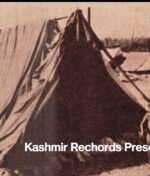
A Lanka in Kashmir!
( Kashmir Rechords Exclusive)
It sounds incredible but it is a fact that Lanka exists in Kashmir! Situated on the Eastern side of the sprawling Wular Lake, the major portion of this Lanka ( island) is presently submerged in water.
A tip of this Lanka, which is presently seen above water, is now known by the name Zain-Lank, for the reason that Sultan Zain-ul-Abidin is believed to have constructed a mosque near the ruins of a Temple which earlier existed on the island ( then called Sona Lank) but was dismantled by Sikander, the iconoclast.

While all of us raise the voice for reconstruction of Martand Temple, hardly any voice has been raised over this very unknown Temple lying in ruins/submerged on this Island (Lanka), in Wular Lake which is connected through Bandipora and Sopore, the two major Towns of North Kashmir.
Zain Lanka on Temple Debris?
According to J&K’s renowned writer, Jyoteeshwar Pathak, the Zeen Lenkh (Zain Lanka) does not find any mention in the Kalhana’s Rajatarangini. In his write-up published in `Kashmir Today’ Magazine ( April-May, 1994) and while quoting Moti Lal Saqi’s Book “Aager Neb’’ , mentions that there was no existence of the island before the 12th century AD, but the same was raised in Wular lake with debris of several dismantled temples which used to be in the vicinity of villages around Wular Lake.
Charles Ellison Bate’s Gazetteer of Kashmir provides similar description stating that during the rule of Zain-ul-Abidin (1420-70) the remains of the temples dismantled by Sikander, the iconoclast were thrown into the Lake where an island was developed and given the name Lanka. Historian Anand Koul Bamzai writes that the Island is no other than Sona-Lankh (the golden island), now called Zain Lank.

Jonaraja, the poet laureate in the court of Zain-ul-Abidin provides a significant evidence about this island. According to him, the surroundings around Wular Lake during 9th Century used to present a unique example of archaeology. The stone laden boats were sailed into Mahapadmasar, (the Wular) and the land thus developed was named as Lenkh (Lanka or Island). A royal palace was built in the lake under the supervision of Engineer Suyya, the 9th century engineer who is identified with Suyyapur (Present-day Sopore), Kashmir.
However, Jyoteeshwar Pathak says that an inscription in the Sri Pratap Singh Museum, Srinagar provides an insight in the existence of this island. This inscription refers to the island as the Zain Lank ( Island).

Mirza Haider Daghlak, a ruler of Kashmir in the early 15th century has been quoted saying, “Zeen Lankh” was an ideal spot for picnics and entertainments. The island was 100 feet long and 75 feet wide. The King had developed a beautiful garden over this island, which included the fruit laden trees and flowers of several kinds. There was a three storey building on the northern side and a beautiful mosque.
Travellers to Kashmir‘s Lanka
François Bernier (1673) in his travelogue provides a detail of the ‘Zain Lankh’. According to him, there was a small hut in the middle of the lake with a small garden adjoining it.
This quadrangle island has perhaps vanished by the time William Moorcroft (1767 – 27 August 1825) visited the site. According to him, the circumference of the island was 300 yard. The structure expected in the island was definitely related to the Indian architectures. These structures are now in a dilapidated stage. He found neither any inscription nor any idol there. The temple pillars were, however, found in the scattered state. There was, however, a quadrangle building on the left side. There were some hutments over the island, which were inhabited by entirely poor people.






Comment
Ravi Magotra
Very informative.